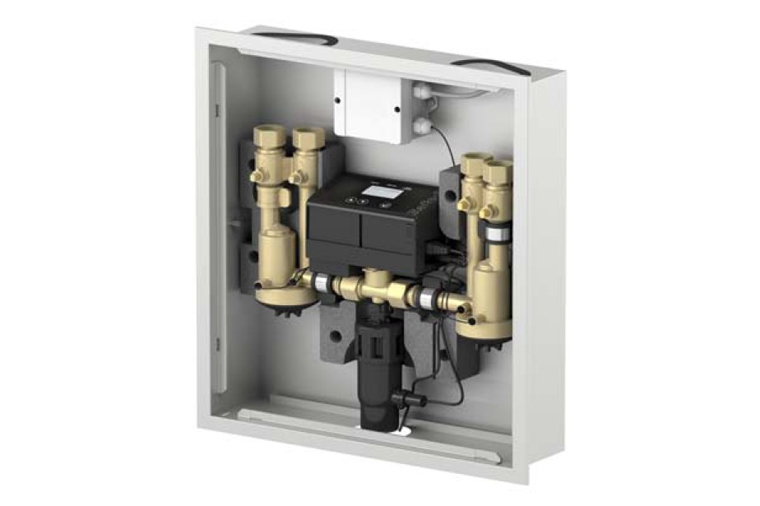Harmful germs in drinking water installations in hospitals are a potential hazard, particularly for people with a weakened immune system. With intelligent products and hygienic materials, the members of the Blue Responsibility initiative make a crucial contribution to protecting patients and hospital personnel against infections.
The strict hygiene rules are the top priority in all areas of a hospital. What patients and most employees do not see are the sanitary installations which ensure clean drinking water. Hospitals usually have a complex network of water pipes. Stagnation and low flow rates, however, promote the formation of Legionella and germs. Rough, fissured surfaces on encrusted pipes or biofilms offer a perfect breeding ground for germs. In addition, insufficient pipe insulation can result in unwanted heating up of the drinking water, promoting germ growth, e.g. of Legionella. “With Legionella, breathing in very fine aerosols – which arise e.g. during showering – is a big problem,” explains Verena Töpfer-König from Franke Aquarotter. “Particularly for people with a weak immune system.” Using low aerosol hand held shower heads and laminar jet controls on the taps, e.g. from Ideal Standard, minimises the transfer of germs into the human body.
Circulation helps to ensure hygiene
Drinking water quality in the building can be negatively affected if the sanitary installations are not carefully maintained – especially for hot water distribution. Honeywell, for example, offers hydraulic balancing for the circulation system as a hygiene precaution. Control valves in the individual stories of the building ensure optimum thermal circulation in complex systems. “The hydraulic circulation balancing protects against the large scale growth of harmful microorganisms such as Legionella while ensuring comfortable hot water dispensing throughout the entire building,” Volker Galonske from Honeywell explains. The measure allows the temperature to be maintained at e.g. 60/55 °C. This prevents the growth of microorganisms and allows fast provision of hot water.
Flushing systems for constant water exchange
“Germs are components of drinking water where we have to minimise the concentration and limit breeding conditions,” Gerhard Weber from Ideal Standard explains. “This includes preventing so-called dead lines where water stagnates.” These allow exponential germ growth. Water can also stagnate in the pipes if not all rooms in a hospital are occupied. Regular flushing is therefore required, ensured by automatic flushing systems. An intelligent control module measures the flow and the temperature ranges for cold and hot water. If the flow rate is too low or if cold and hot water move outside the defined settings, the pipes are flushed with individually adjustable water volumes. The settings can also be made through an app. A hygiene module from Syr works with a similar principle: the app provides the user with an overview and access to important parameters such as flushing intervals and temperatures. In addition, the valve acts as a rinsing station and detects stagnation and incorrect temperatures.
“To prevent water stagnation, demand-oriented pipe sizes and reasonable insulation are practical and necessary from the outset,” says Veit Szpak from Mepa. The pipes should be checked for the current requirements and as to whether filters, hot water tanks and valves are clean and functioning. “The technical regulations for drinking water installations stipulate that proper operation is the responsibility of the operating company or of the user of the connection. The German Drinking Water Ordinance refers to this generally accepted state of the art in several places,” Volker Röttger from Geberit explains. “We as a sanitary technology manufacturer provide sustainable solutions which make it easy for the operating companies from the outset to comply with the regulations in the long term.” The hygiene system from Kemper also prevents stagnation while focusing on the ecological aspect. The hygiene flushing is installed as an independent unit at the end of all serial lines and provides an exchange of the water volume in the direction of flow from the house connection to the flushing station. In hospitals, manufacturers recommend using hygiene flushing in combination with Venturi flow distributors. The number of flushing stations can be significantly reduced as they are only used at the end of lines or stories as final flushing units.
Intelligent sanitary solutions ensure drinking water hygiene
The German sanitaryware industry has developed intelligent systems for ensuring drinking water hygiene in hospitals in the long term. “Ensuring thorough planning, efficiency, durability and sustainability of the sanitary solutions from the start removes the need for intervening with the infrastructure later on, which can result in high costs and affect hygiene,” Wolfgang Burchard from Blue Responsibility sums up.
